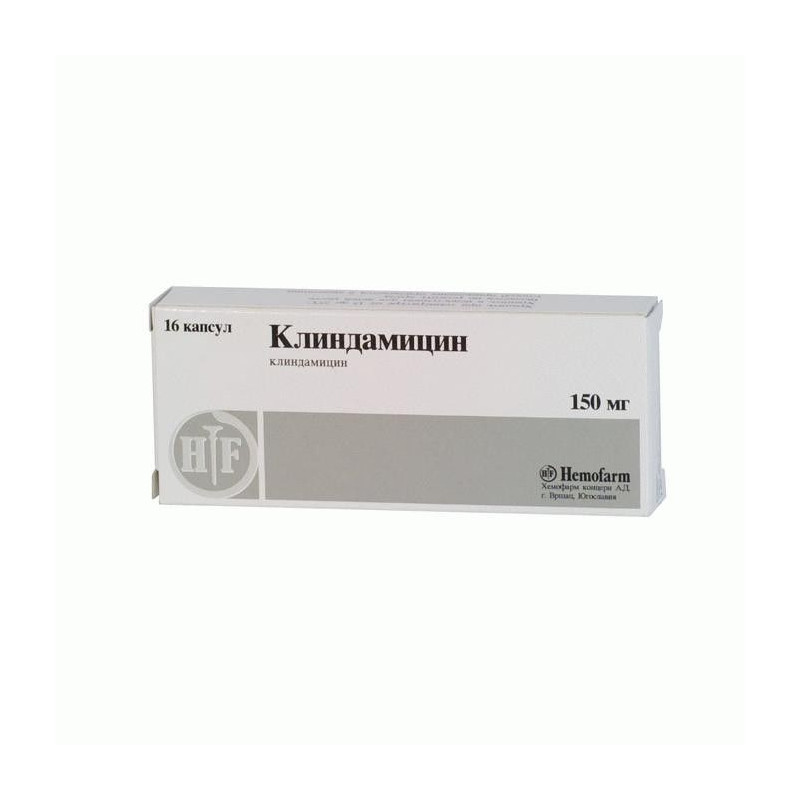



 All payments are encrypted via SSL
All payments are encrypted via SSL
 Full Refund if you haven't received your order
Full Refund if you haven't received your order
In the blister 8 capsules. In a carton box 2 blisters.
Clindamycin is a drug from the group of antibiotics - lincosamides, has a broad spectrum of action, is bacteriostatic, binds to the 50S subunit of the ribosome and inhibits protein synthesis in microorganisms.
Active in relation to:
- Staphylococcus spp. (including Staphylococcus epidermidis producing penicillinase).
- Streptococcus spp. (excluding Enterococcus spp.).
- Streptococcus pneumoniae.
- Anaerobic and microaerophilic gram-positive cocci (including Peptococcus spp. And Peptostreptococcus spp.).
- Corynebacterium diphtheriae.
- Clostridium perfringens.
- Clostridium tetani.
- Mycoplasma spp.
- Bacteroidesspp. (including Bacteroides fragilis and Bacteroides melaningenicus).
- Anaerobic gram-positive, non-spore-forming bacilli (including Propionibacterium spp., Eubacterium spp., Actinomyces spp.).
Most of the strains of Clostridium perfringens are sensitive to Clindamycin, but other types of clostridia (Clostridium sporogenes, Clostridium tertium) are resistant to the drug, therefore, for infections caused by Clostridium spp., The definition of an antibioticogram is recommended.
The mechanism of action and the antimicrobial spectrum is close to Lincomycin (for some types of microorganisms, especially with respect to bacteroids and non-spore-forming anaerobes, 2-10 times more active).
- On the part of the digestive system: dyspepsia (abdominal pain, nausea, vomiting, diarrhea), esophagitis, jaundice, abnormal liver function, hyperbilirubinemia, dysbacteriosis, pseudomembranous enterocolitis.
- From the musculoskeletal system: Rarely - a violation of neuromuscular conduction.
- From the side of blood-forming organs: Leukopenia, neutropenia, agranulocytosis, thrombocytopenia.
- Allergic reactions: Rarely - maculopapular rash, urticaria, pruritus. In some cases, exfoliative and vesicular-dermatitis, eosinophilia, anaphylactoid reactions.
- From the side of the cardiovascular system: Dizziness, weakness.
- Other: The development of superinfection.
- Application for violations of the liver: Clindamycin is used with caution in patients with severe liver failure. Patients need to monitor liver function (liver enzymes).
- Application for violations of kidney function: Clindamycin is used with caution in patients with severe renal insufficiency.
Pseudomembranous colitis can appear both on the background of clindamycin intake, and 2-3 weeks after stopping treatment (3-15% of cases); manifested by diarrhea, leukocytosis, fever, pain in the abdomen (sometimes accompanied by the release of blood and mucus from the stool).
If these phenomena occur in mild cases, it is enough to cancel the treatment and use of ion exchange resins (Kolestiramine, Colestipol), in severe cases, it is shown to replace the loss of fluid, electrolytes and protein, the administration of Vancomycin orally or Metronidazole.
Do not use drugs that inhibit intestinal peristalsis.
The safety of the drug in children up to 3 years has not been established. With long-term therapy, children need periodic monitoring of the blood formula and the functional state of the liver.
In the appointment of the drug in high doses, it is necessary to control the concentration of clindamycin in the plasma.
- Symptoms: possible increased side effects.
- Treatment: symptomatic therapy, there is no specific antidote. Hemodialysis and peritoneal dialysis are ineffective.
- Store at a temperature of 15-25 ° C.
- Keep out of reach of children.
- Do not use after expiration date.
